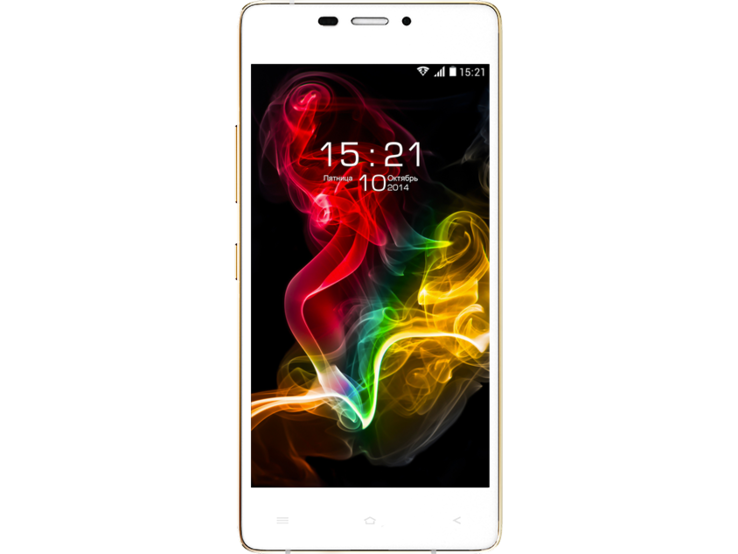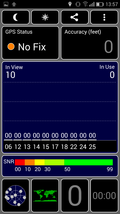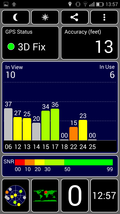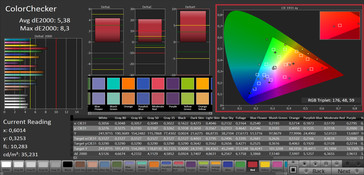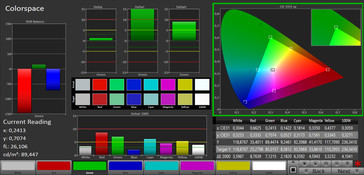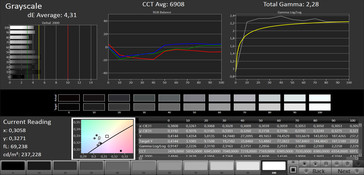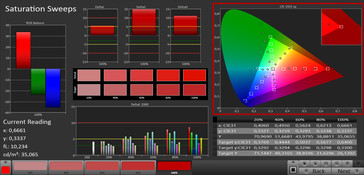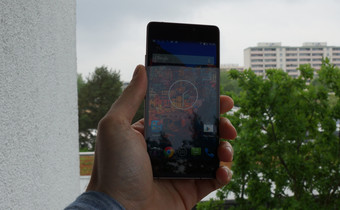Kazam Tornado 348 Smartphone Review

For the original German review, see here.
When a manufacturer names its smartphones after wild natural forces like "Thunder" or "Tornado", our first suspicion would be that they come from China. Well, prejudices like this can be misleading, and Kazam is not based in China but a European Island, where black tea and black sausages for breakfast have a long tradition: Great Britain. This does not mean that the manufacturer would be very restrained – the name is already a slang expression, which can be used in multiple ways, including the expression of a joyful surprise.
We just reviewed one device from Kazam so far: the Thunder Q4.5. We liked it, but there were issues in respect of the camera and the battery runtime. Now we have a look at the Tornado 348; according to the manufacturer and Guinness World Records, it is the thinnest smartphone in the world. Otherwise, you get mainstream specifications and a pretty self-confident recommended retail price.
Priced at 300 Euros (~$329), it will be competing with good rivals like the thin OnePlus One and aluminum-clad Samsung Galaxy A3. Other competitors for the Kazam Tornado 348 are the Honor 6 or Nokia Lumia 735.
Case
You cannot really say in advance what kind of chassis you get for 300 Euros (~$329), but you should at least be able to expect a high-quality plastic chassis. The Kazam Tornado 348 even goes a step further and uses a dark gray chassis made of an aluminum-magnesium alloy in combination with Gorilla Glass at the front and back. The smartphone is also available in white. The glossy surface on the back is susceptible to fingerprints and does not provide much grip.
We already mentioned that it is the thinnest smartphone in the world, more precisely 5.15 millimeters (~0.2 in) thin. The Tornado 348 actually has a flawless build quality and is sturdy: neither pressure nor attempts to twist the device are a problem, and you can only hear slight creaking sounds. It is not possible to open the chassis.
Connectivity
One of the biggest problems of the Kazam Tornado 348 is probably related to the ultra-thin design: The storage of just 16 GB cannot be expanded. The Tornado 348 does at least support USB OTG, so you can attach USB storage to save more data. This solution is, however, obviously not perfect. LTE is not supported, either, so the connectivity is rather middling. You can extend the manufacturer's warranty in return: Register your device on the website and you get three years instead of just two.
Software
Kazam does not experiment in terms of the operating system and uses the proven Android 4.4 with some small changes: There is a summary of frequently used settings, which makes the menu a bit simpler.
Except for a preloaded flashlight and an emergency app, you should not expect too many apps. This does at least mean that almost 12 GB of the internal storage are free for your own files.
Communication & GPS
You should lower your expectations for the Tornado 348 in respect of the frequencies: GSM quad-band and UMTS dual-band will have to be sufficient, and LTE is not supported. We like the fact that you do not have to restart the smartphone when you insert a micro-SIM, and the signal quality is pretty good in the German o2/E-Plus network in the metropolitan area.
The WLAN support is limited as well: More than 802.11 b/g/n is not possible, but the transfer rates with up to 300 Mbps are actually sufficient in practice. It is, however, unfortunate that you cannot use 5 GHz networks, which would be an advantage particularly in areas with a lot of WLAN networks.
The GPS module cannot locate us indoors, and it also takes quite a while outdoors, but after that the performance is very good and the accuracy is down to 4 meters (~13 feet).
Telephone & Voice Quality
Kazam reworked the phone app: The interface is very limited. At first, you see the keyboard, enter a phone number and either save it as a new contact or add it to an existing one. You can also use the letters on the number keys to search for a contact, which works, but we do not think that it is the most practical method. Previous calls are shown on the same screen. The interface is generally very simple and modern, but we think it is not as good as the standard app from Google.
We can hear the other person very clearly and the voice is also pretty loud at the highest volume, but there will quickly be slight distortions. The microphone of our unit, on the other hand, does not leave such a good impression: It records our voice pretty well, but distorts quickly and there is hardly any filtering out of background noises.
Cameras & Multimedia
The camera equipment of the Kazam Tornado 348 is the standard for a middle-class device with an 8 MP sensor plus LED flash at the back as well as a 5 MP webcam at the front. The pictures taken from the rear camera look crisp and have good colors in bright environments, but you can see blurry edges and some picture noise when you have a closer look. The colors are still decent when the lighting gets worse, but you can still see some picture noise and details are still blurry. The drawbacks of the camera are generally only visible when you enlarge the pictures, so it can be used for snapshots. Full HD videos are possible with 30 fps and the overall quality is decent.
The front camera, with a generous 5 MP resolution sensor, should be sufficient for selfies, but you should not get too close, otherwise you can see a distinct mosaic effect for details and individual pixels. However, we can say the same here: The quality is okay for snapshots.
Input Devices & Handling
The virtual keyboard is the standard model from Google and should be familiar by now: Clear and simple structure, reliable and easily customized. Swipe inputs are possible as well. Another thing we noticed: The vibration of the Kazam Tornado 348 is very strong when you press a key, but it can obviously be deactivated.
Three touch buttons are located underneath the display and can be operated very precisely, just like the touchscreen itself. It is reliable up into the peripheral areas and usually executes our inputs quickly.
Display
Kazam uses an AMOLED display with a resolution of 1280x720 pixels for its smartphone. This is standard for this class, and some rivals like the Samsung Galaxy A3 even have panels with a lower resolution. However, AMOLED displays with organic LEDs often have the problem that the maximum brightness is not as high compared to classic LED displays. This is also the case for our Tornado 348 review unit: An average luminance of 240.1 cd/m² is lower average at best. The brightness distribution is at least very even at 92%, so you cannot see brightness differences even over large areas.
The manufacturer offers a great service: If the display should be damaged, the glass will be repaired once for free.
| |||||||||||||||||||||||||
Brightness Distribution: 92 %
Center on Battery: 240 cd/m²
Contrast: ∞:1 (Black: 0 cd/m²)
ΔE ColorChecker Calman: 5.38 | ∀{0.5-29.43 Ø4.78}
ΔE Greyscale Calman: 4.31 | ∀{0.09-98 Ø5}
Gamma: 2.28
CCT: 6908 K
| Kazam Tornado 348 Mali-450 MP4, MT6592, 16 GB eMMC Flash | Samsung Galaxy A3 Adreno 306, 410 MSM8916, 16 GB eMMC Flash | OnePlus One Adreno 330, 801 MSM8974AC, 64 GB eMMC Flash | Honor 6 Mali-T628 MP4, Kirin 920, 16 GB eMMC Flash | Nokia Lumia 735 Adreno 305, 400 MSM8926, 8 GB eMMC Flash | |
|---|---|---|---|---|---|
| Screen | 50% | 12% | 10% | 20% | |
| Brightness middle (cd/m²) | 240 | 434 81% | 423 76% | 439 83% | 291 21% |
| Brightness (cd/m²) | 240 | 433 80% | 408 70% | 439 83% | 293 22% |
| Brightness Distribution (%) | 92 | 96 4% | 83 -10% | 93 1% | 93 1% |
| Black Level * (cd/m²) | 0.54 | 0.8 | |||
| Colorchecker dE 2000 * | 5.38 | 2.98 45% | 5.56 -3% | 7.06 -31% | 4.04 25% |
| Greyscale dE 2000 * | 4.31 | 2.68 38% | 7.55 -75% | 8.08 -87% | 2.87 33% |
| Gamma | 2.28 96% | 2.44 90% | 2.33 94% | 2.16 102% | 2.49 88% |
| CCT | 6908 94% | 6603 98% | 7624 85% | 8134 80% | 6432 101% |
| Contrast (:1) | 783 | 549 |
* ... smaller is better
While the brightness is a problem area of some AMOLED panels, they excel in terms of contrast: The individual LEDs can be completely deactivated, so black areas are not illuminated and therefore completely dark. This results in an infinitely high contrast, at least in theory, which results in glowing colors. Subjectively, we like the display a lot thanks to the rich colors and the very vivid picture impression.
We perform our objective display measurements with the software CalMAN and a spectrophotometer. Colors are generally visibly oversaturated compared to the reference sRGB color space. This does create a vivid picture impression, but it is not perfect if you have to rely on the colors, when you want to adjust the saturation of a picture, for example. Still, the deviations are not too big, and you can only see a slight blue cast, but it is hardly noticeable.
The high contrast is a big advantage outdoors. The low brightness, on the other hand, makes it difficult to see the display content in bright environments. This means the overall impression is pretty mixed, but you should be able to use the display of the Tornado 348 on cloudy days and indoors.
Performance
The Mediatek MT6592 with eight cores and a clock of 1.7 GHz is a mainstream SoC and is the heart of the Kazam Tornado 348. It should provide sufficient performance for most applications. Even though the eight cores sound good, the performance advantage is not terribly big. The review unit therefore only has an advantage compared to the Lumia 735, but both the Honor 6 and obviously the OnePlus One are much faster in respect of the processor performance. Still, the performance is sufficient in practice based on our experiences. Most competitors are also faster during web browsing.
Graphics calculations are handled by the ARM Mali-450 MP4, which should also be powerful enough for higher resolutions. You can notice that in the benchmarks: The 3D performance is only beaten by the Honor 6 and the OnePlus One, but the Samsung Galaxy A3 falls behind.
The storage is fast, at least faster than the Honor 6 and it beats the Samsung Galaxy A3 in terms of writing performance. Still, our review unit has no chance against the excellent storage performance of the OnePlus One.
| Linpack Android / IOS | |
| Single Thread (sort by value) | |
| Kazam Tornado 348 | |
| OnePlus One | |
| Nokia Lumia 735 | |
| Honor 6 | |
| Multi Thread (sort by value) | |
| Kazam Tornado 348 | |
| OnePlus One | |
| Nokia Lumia 735 | |
| Honor 6 | |
| Smartbench 2012 | |
| Productivity Index (sort by value) | |
| Kazam Tornado 348 | |
| OnePlus One | |
| Honor 6 | |
| Samsung Galaxy A3 | |
| Gaming Index (sort by value) | |
| Kazam Tornado 348 | |
| OnePlus One | |
| Honor 6 | |
| Samsung Galaxy A3 | |
| AnTuTu v5 - Total Score (sort by value) | |
| Kazam Tornado 348 | |
| OnePlus One | |
| Honor 6 | |
| Geekbench 3 | |
| 32 Bit Single-Core Score (sort by value) | |
| OnePlus One | |
| Honor 6 | |
| Samsung Galaxy A3 | |
| 32 Bit Multi-Core Score (sort by value) | |
| OnePlus One | |
| Honor 6 | |
| Samsung Galaxy A3 | |
| Sunspider - 1.0 Total Score (sort by value) | |
| Kazam Tornado 348 | |
| OnePlus One | |
| Nokia Lumia 735 | |
| Honor 6 | |
| Samsung Galaxy A3 | |
| Octane V2 - Total Score (sort by value) | |
| Kazam Tornado 348 | |
| Nokia Lumia 735 | |
| Honor 6 | |
| Samsung Galaxy A3 | |
| Mozilla Kraken 1.1 - Total (sort by value) | |
| Kazam Tornado 348 | |
| OnePlus One | |
| Nokia Lumia 735 | |
| Honor 6 | |
| Samsung Galaxy A3 | |
| 3DMark | |
| 1280x720 Ice Storm Standard Score (sort by value) | |
| Kazam Tornado 348 | |
| 1280x720 Ice Storm Standard Graphics (sort by value) | |
| Kazam Tornado 348 | |
| 1280x720 Ice Storm Standard Physics (sort by value) | |
| Kazam Tornado 348 | |
| 1920x1080 Ice Storm Extreme Score (sort by value) | |
| Kazam Tornado 348 | |
| Honor 6 | |
| Samsung Galaxy A3 | |
| 1920x1080 Ice Storm Extreme Graphics (sort by value) | |
| Kazam Tornado 348 | |
| Honor 6 | |
| Samsung Galaxy A3 | |
| 1920x1080 Ice Storm Extreme Physics (sort by value) | |
| Kazam Tornado 348 | |
| Honor 6 | |
| Samsung Galaxy A3 | |
| 1280x720 offscreen Ice Storm Unlimited Score (sort by value) | |
| Kazam Tornado 348 | |
| OnePlus One | |
| Honor 6 | |
| Samsung Galaxy A3 | |
| 1280x720 offscreen Ice Storm Unlimited Graphics Score (sort by value) | |
| Kazam Tornado 348 | |
| OnePlus One | |
| Honor 6 | |
| Samsung Galaxy A3 | |
| 1280x720 offscreen Ice Storm Unlimited Physics (sort by value) | |
| Kazam Tornado 348 | |
| OnePlus One | |
| Honor 6 | |
| Samsung Galaxy A3 | |
| GFXBench (DX / GLBenchmark) 2.7 | |
| T-Rex Onscreen (sort by value) | |
| Kazam Tornado 348 | |
| OnePlus One | |
| Nokia Lumia 735 | |
| Honor 6 | |
| Samsung Galaxy A3 | |
| 1920x1080 T-Rex Offscreen (sort by value) | |
| Kazam Tornado 348 | |
| OnePlus One | |
| Nokia Lumia 735 | |
| Honor 6 | |
| Samsung Galaxy A3 | |
| AndroBench 3-5 | |
| Sequential Read 256KB (sort by value) | |
| Kazam Tornado 348 | |
| OnePlus One | |
| Honor 6 | |
| Samsung Galaxy A3 | |
| Sequential Write 256KB (sort by value) | |
| Kazam Tornado 348 | |
| OnePlus One | |
| Honor 6 | |
| Samsung Galaxy A3 | |
| Random Read 4KB (sort by value) | |
| Kazam Tornado 348 | |
| OnePlus One | |
| Honor 6 | |
| Samsung Galaxy A3 | |
| Random Write 4KB (sort by value) | |
| Kazam Tornado 348 | |
| OnePlus One | |
| Honor 6 | |
| Samsung Galaxy A3 | |
* ... smaller is better
Games
Game control is very good on the Kazam Tornado 348: The precise touchscreen and the position sensor allow a good control of the games. The graphics card is even powerful enough for complex 3D games like "Asphalt 8: Airborne". The game is not completely smooth at the highest settings, but the small stutters do not affect the gaming experience and are not that noticeable in-game compared to the intro sequences. Simpler games like "Angry Birds" or "Candy Crush" are no problem for the smartphone.
Emissions
Temperature
The Kazam Tornado 348 gets noticeably warm while idling, especially at the top and around the cameras at the front and the back, which is obviously the location of the SoC. The thin construction is definitely noticeable here, but the temperatures are still not uncomfortable, reaching up to 36.1 °C (96.98 °F).
More load for the smartphone results in a maximum temperature of 39.7 °C (103.46 °F), once again around the cameras. This temperature is not critical, either, but you can definitely feel the warming.
(+) The maximum temperature on the upper side is 39.7 °C / 103 F, compared to the average of 35.2 °C / 95 F, ranging from 21.9 to 247 °C for the class Smartphone.
(+) The bottom heats up to a maximum of 37.5 °C / 100 F, compared to the average of 34 °C / 93 F
(±) In idle usage, the average temperature for the upper side is 32.7 °C / 91 F, compared to the device average of 32.9 °C / 91 F.
Speakers
The speakers are on the back of the smartphone and can be covered by soft surfaces or the hand. This will result in a muffled sound, but it is not very powerful in the first place: The maximum volume of the speaker is average and not sufficient for larger rooms. The sound is at least clear and free of distortions at maximum volume. The sound is decent, bass is missing completely, but the balance between high and medium tones is agreeable.
If you like to watch videos or listen to music, you should attach headphones: The resulting sound via 3.5 mm stereo jack is very good.
Energy Management
Power Consumption
The smartphone does not consume any power when it is turned off and just 0.1 W during standby – this is very good. The consumption will quickly rise to 1.4 W when you turn on the display. Even the much more powerful OnePlus One only needs half of that at 0.7 W. There are, however, other smartphones with an even higher consumption: The Honor 6 consumes 1.7 W in this scenario. We measured a maximum consumption of 2.2 W while idling for the Kazam Tornado 348.
The review unit is reasonably frugal under load and the consumption is adequate with at least 3.4 W and up to 5.8 W, but it will not break any efficiency records.
| Off / Standby | |
| Idle | |
| Load |
|
Key:
min: | |
Battery Runtime
The results of the current version 1.3 of our WLAN test and the older version, which we used for the majority of comparison devices, cannot be directly compared. The current version determines much shorter runtimes but is also more realistic, because HTML 5 contents with videos on the web are more complex. The Kazam Tornado 348 only manages slightly more than 5 hours, so the review unit still falls behind the rivals despite the new test. Only the Honor 6 manages similar runtimes.
The battery capacity of 7.79 Wh is also much smaller compared to the Honor 6, so the Kazam Tornado 348 actually manages decent runtimes with its acceptable consumption values. The smartphone from the British manufacturer will manage a standard business day, but you will have to charge it overnight.
| Kazam Tornado 348 Mali-450 MP4, MT6592, 16 GB eMMC Flash | Samsung Galaxy A3 Adreno 306, 410 MSM8916, 16 GB eMMC Flash | OnePlus One Adreno 330, 801 MSM8974AC, 64 GB eMMC Flash | Honor 6 Mali-T628 MP4, Kirin 920, 16 GB eMMC Flash | Nokia Lumia 735 Adreno 305, 400 MSM8926, 8 GB eMMC Flash | |
|---|---|---|---|---|---|
| Battery runtime | 87% | 120% | -4% | 117% | |
| WiFi v1.3 (h) | 5 | 16.1 222% | |||
| Load (h) | 2.3 | 4.3 87% | 2.7 17% | 2.2 -4% | 5 117% |
| WiFi (h) | 9.5 | 18.8 | 7.6 | 12.7 |
Pros
Cons
Verdict
We cannot really say that the Kazam Tornado 348 can rough up the mainstream competition. It certainly has some positive aspects like the extremely thin, sturdy and nice chassis or the display with its rich colors and the good viewing angles.
You will, however, also have to live with some drawbacks in return: The limited connectivity without microSD reader, LTE or 5 GHz WLAN is just one example, but the low luminance of the screen and the short battery runtimes are also not reflective of the somewhat high price.
If you pay a lot of attention to the design and just have a mainstream budget, then the Tornado 348 is a smartphone with a spectacular chassis. The internals, unfortunately, cannot keep up with that.
Kazam Tornado 348
- 05/23/2015 v4 (old)
Florian Wimmer




